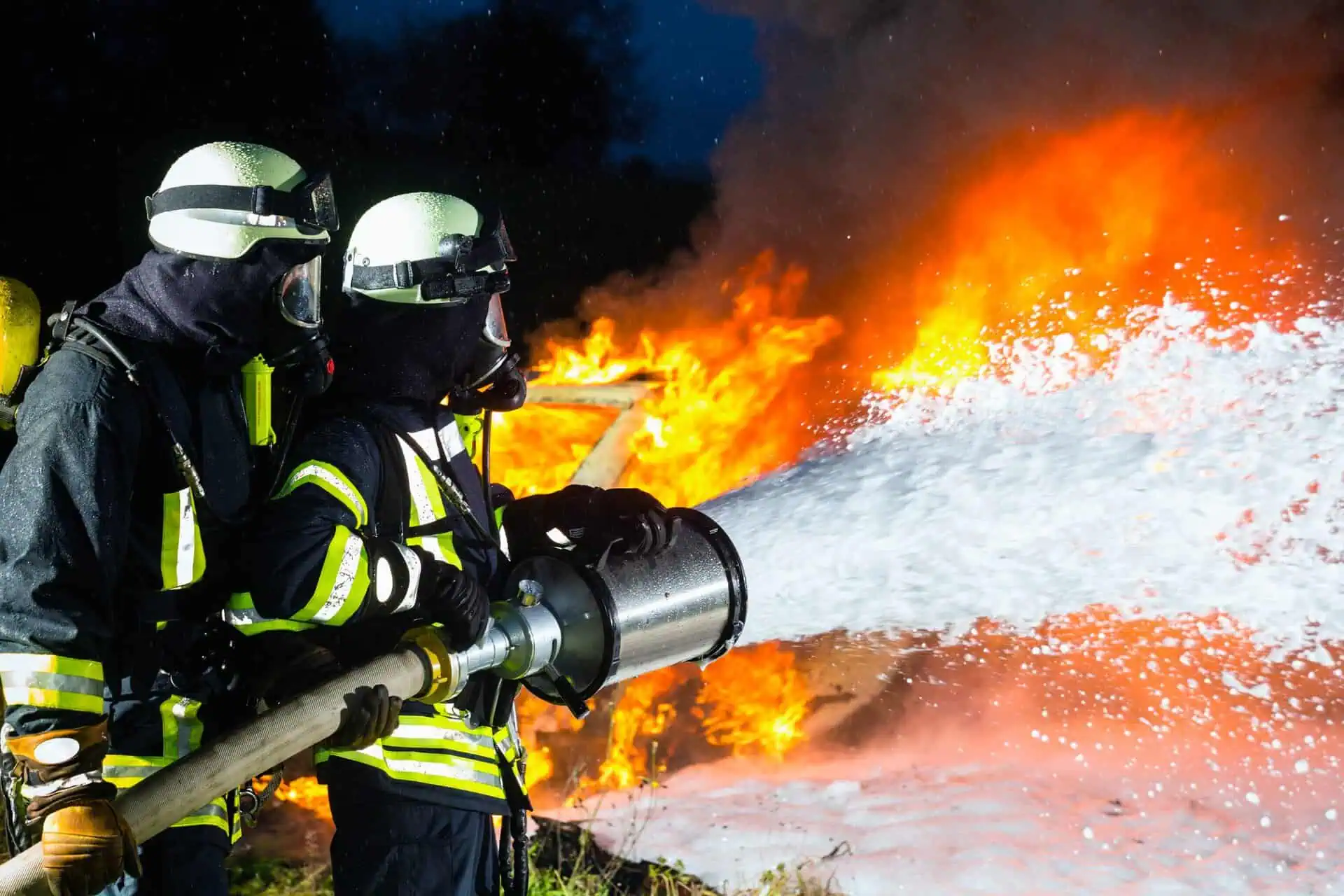AFFF Lawsuit To Enhance Safety Of Firefighting Practices
- Last Updated: June 12th, 2025

Attorney Jessica Paluch-Hoerman, founder of TruLaw, has over 28 years of experience as a personal injury and mass tort attorney, and previously worked as an international tax attorney at Deloitte. Jessie collaborates with attorneys nationwide — enabling her to share reliable, up-to-date legal information with our readers.
Legally Reviewed
This article has been written and reviewed for legal accuracy and clarity by the team of writers and legal experts at TruLaw and is as accurate as possible. This content should not be taken as legal advice from an attorney. If you would like to learn more about our owner and experienced injury lawyer, Jessie Paluch, you can do so here.
Fact-Checked
TruLaw does everything possible to make sure the information in this article is up to date and accurate. If you need specific legal advice about your case, contact us by using the chat on the bottom of this page. This article should not be taken as advice from an attorney.
Key takeaways:
- Current AFFF lawsuits allege manufacturers were aware of health risks but continued production.
- Lawsuits aim to hold manufacturers responsible for health risks associated with PFAS chemicals in AFFF foam.
- Properly disposing of AFFF foam is important to mitigate liability and enhance firefighting safety.
AFFF Lawsuit To Enhance Safety Of Firefighting Practices
On this page, we’ll discuss improving firefighting safety practices through the AFFF Lawsuit, AFFF Foam Disposal Practices, who qualifies to file an AFFF Lawsuit, and much more.
Intro to the AFFF Lawsuit
Filing an AFFF lawsuit against the manufacturers of Aqueous Film Forming Foam (AFFF) helps promote safer firefighting practices.
The suits argue that companies such as 3M and DuPont, known for producing this foam, failed to warn users about the carcinogenic properties of the product.
Various scientific studies link exposure to PFAS present in AFFF foam with potentially deadly conditions like prostate, testicular, and kidney cancer.
These legal skirmishes have sparked meaningful discussion on improving safety measures within firefighting spaces.
As part of these efforts, experts are now exploring alternatives to the hazardous AFFF foam.
Many departments already seek safer substitutes that balance effectiveness with reduced health risks, echoing concerns raised by various studies and pending lawsuits.
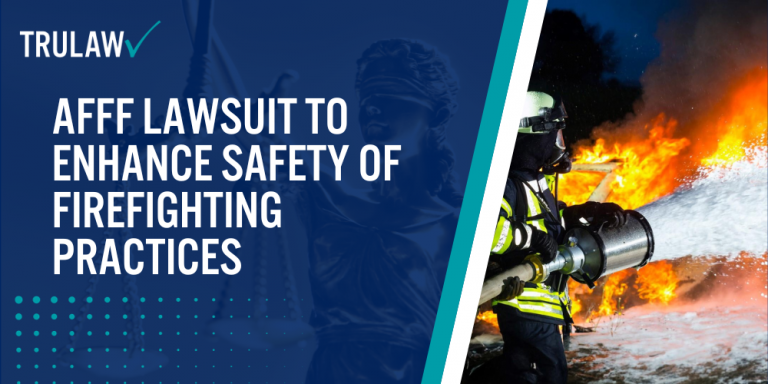
These innovative improvements meet strict legal requirements guarding against dangerous chemical exposures while upholding required safety standards among firefighters.
Integrating insights gathered from ongoing litigation serves an added purpose – it allows community members to understand better connections between environmental contamination and public health threats linked to prolonged contact with toxic chemicals in popular firefighting aids like AFFF foams.
Lastly, it exposes a need for stricter regulatory responses capable of curtailing continued misuse or unregulated access to hazardous materials frequently implicated in personal injury claims filed across different courts nationwide.
Table of Contents
AFFF Foam Alternatives for Safer Firefighting Practices
Recognizing the health risks associated with Aqueous Film Forming Foam (AFFF), researchers and scientists have developed safer alternatives for combating liquid fuel fires.
Some of these substitutes even surpass AFFF in firefighting effectiveness, posing fewer threats to health and the environment.
Innovations rapidly lead us towards PFAS-free foams, significantly lowering the potential toxicity for firefighters and those exposed during a fire.
Among these innovations, fluorine-free foams stand out due to their superior balance of safety and efficacy.
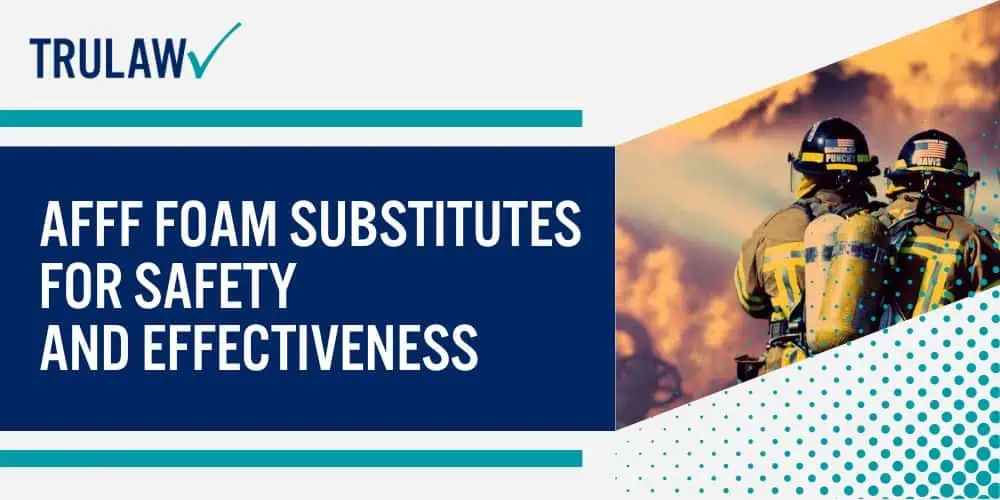
These novel firefighting agents do not contain any PFAS compounds, alleviating many environmental or health concerns linked to traditional AFFF use.
Firefighting equipment advancements also facilitate the transition from conventional strategies by accommodating new foam technologies without compromising efficiency or risk management.
Exploring AFFF Substitutes: Safety and Effectiveness
In an effort to prioritize safety, researchers are tirelessly investigating non-toxic alternatives to Aqueous Film Forming Foam (AFFF).
These alternatives can potentially reduce dangerous exposures for firefighters and limit environmental impact.
The safe alternative GreenFire Firefighting Foam (GFFF), a Class B foam, has a proven track record of extinguishing fuel fires on ships and airplanes without toxic implications.
The effectiveness of fluorine-free replacements for AFFF is another significant area of study.
Despite their reduced environmental footprint, these substitutes must still display robust firefighting capabilities.
Substantial testing protocols evaluate each product’s fire suppression efficiency, ensuring that new solutions can confidently replace traditional foams in high-risk scenarios.
Efforts are compounding to identify safer options and fully grasp the health effects of AFFF exposure.
Comprehending these symptoms will inform future protective measures and contribute to establishing more secure firefighting practices across the industry.
Comparing AFFF Alternatives: A Comprehensive Analysis
In light of the AFFF lawsuits, a comprehensive analysis of its alternatives is crucial.
It’s important to note that these alternatives must meet legal requirements and safety standards in light of the AFFF lawsuits.
Moreover, manufacturers must ensure their products do not pose health risks like AFFF, which has been linked to different types of cancer.
Manufacturers like 3M and DuPont face allegations of knowingly selling carcinogenic AFFF, further emphasizing the need for safer alternatives.
Transitioning to Safer Firefighting Agents: Challenges and Solutions
Switching to safer firefighting agents, such as fluorine-free foam (F3), isn’t difficult.
Firefighting teams face multiple hurdles in this transition, from finding efficient alternatives to the traditional AFFF Foam Cancer to adapting their tactics and techniques for these new tools.
Due to property variances, F3 foams require different handling strategies than their AFFF counterparts.
Training firefighters on these changes is vital yet challenging, especially considering the urgency of their profession.
The solutions require a collective effort amongst several parties.
Manufacturers must continue developing effective and safe substitutes for AFFF that meet fire suppression needs while posing minimal risks to health and the environment.
Regulatory measures are necessary, too, pushing for standards that consider both the effectiveness and safety of newer firefighting agents.
Simultaneously, increased investment in firefighter education can ensure preparedness to use these alternatives during emergencies, preventing potential mishaps and ensuring optimal performance.
AFFF Lawsuits in Firefighter Training and Bridging the Gap
AFFF lawsuits have drastically changed how firefighter training is conducted.
A major concern has been the widespread use of Aqueous Film Forming Foam (AFFF) in firefighting practices due to its suspected links with cancer and other adverse health effects.
These legal cases underscore the need for comprehensive training that equips firefighters with safer, less toxic alternatives.
The gap in knowledge about AFFF risks during firefighter training demands immediate attention.
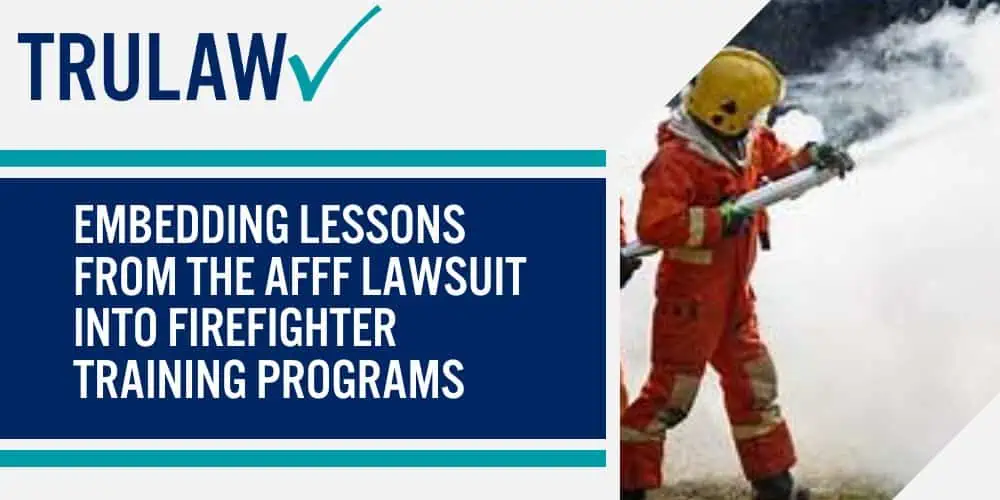
Firefighters should understand the dangers of these foams and how to handle them safely without compromising their effectiveness against fires.
Consequently, an ongoing effort is required to ensure every member of a firefighting team receives this critical safety information.
Many fire departments are implementing rigorous education programs about potential hazards related to certain firefighting substances like AFFF foam to address this issue.
They continue searching for safer substitutes without sacrificing crucial fire suppression capabilities from their toolkit.
Ultimately, these changes aim to protect firefighters and secure public health and our environment.
Furthermore, laws are being revised, and enforcement measures are strengthened to boost adherence to new standards emphasizing risk reduction from harmful substances like AFFF foam used to extinguish flames during emergencies or drills.
Such regulatory strides mark significant progress towards bridging the gaps exposed by recent lawsuits and enhancing overall preparedness within firefighting ranks.
Integrating AFFF Lawsuit Insights into Firefighter Training
Understanding the dangers of AFFF exposure is a vital part of firefighter training.
Key points to note in understanding firefighter training and AFFF exposure
- AFFF lawsuits indicate that prolonged exposure to AFFF foams can lead to serious health risks.
- Topics from real-life AFFF lawsuit cases should be included in firefighting courses to inform trainees about occupational safety practices.
- Knowledge gained from these lawsuits can contribute significantly to designing training programs focused on the safe usage and disposal of AFFF foams.
- Training should emphasize the optimal use of firefighting equipment that minimizes the need for AFFF foam, reducing potential health risks.
- Educating firefighters about the legal implications and settlements related to AFFF exposure is important to ensure they understand their rights and possible compensations.
- Lessons from past lawsuits, like those involving 3M and DuPont, should be used as case studies in training programs to understand better what went wrong.
- Following best practices for handling toxic chemicals is critical, which can be taught using insights from these lawsuits.
- Detailed information about adverse health effects linked with AFFF exposure should be integral to safety briefings based on insights gathered from personal injury claims in relevant litigation.
- Understanding regulatory responses and updates about recent AFFF litigation helps trainees stay informed about changes in firefighting practices and policies.
- Firefighter training programs must incorporate teachings around the environmental impact of improper disposal or leakage of harmful substances, like those in certain firefighting foams.
Training for AFFF-Free Practices: Bridging the Knowledge Gap
There is a significant need for training in AFFF-free practices amid ongoing lawsuits against manufacturers like 3M and DuPont.
This training aims to enlighten firefighters about the potential health risks associated with occupational exposure to AFFF firefighting foam and promote safety measures.
The objective is clear: equip current and future firefighters with essential knowledge and skills about using safer firefighting alternatives.
Equally important, this instruction helps bridge the knowledge gap concerning toxic chemicals found in AFFF foams.
Eventually, these educational initiatives on adverse health effects related to AFFF exposure are expected to pave the way for more effective firefighting techniques that do not compromise safety or health.
Therefore, encouraging such learning opportunities may prove key in transitioning safely towards entirely AFFF-free practices.
Firefighter Preparedness in the Era of AFFF Lawsuits
Firefighting agencies across the United States are adapting to the era of AFFF lawsuits by enhancing their procedures for safety and preparedness.
They’re revising training programs, incorporating lessons learned from incidents involving Aqueous Film Forming Foam (AFFF).
These updates focus on minimizing exposure risks to harmful chemicals found in traditional firefighting foams.
As an integral part of this transition, fire departments are exploring alternatives to traditional AFFF products.
Numerous substitutes have emerged, claiming equivalent firefighting effectiveness and minimized environmental impacts.
Carefully analyzing and selecting these alternatives has become a new facet of firefighter readiness.
Unsurprisingly, gear enhancements have also been prioritized as part of revised safety measures.
Firefighters now utilize personal protective equipment (PPE) to mitigate any residual risks associated with potentially hazardous foam residues.
This focused move towards safer firefighting practices is reshaping how firefighters prepare for emergencies while ensuring they maintain peak performance in service delivery.
AFFF Lawsuit and Environmental Impact for Safety Enhancements
The AFFF lawsuits have necessitated reevaluating firefighting practices and their potential ecological harm.
The main issue is the presence of PFAS substances in AFFF foam, which has contaminated municipal water systems and wreaked havoc on environmental health.
Manufacturers are accused of concealing these detrimental effects and promoting the hazardous product.
This legal action has significantly shifted towards environmentally friendly alternatives in the firefighting industry.
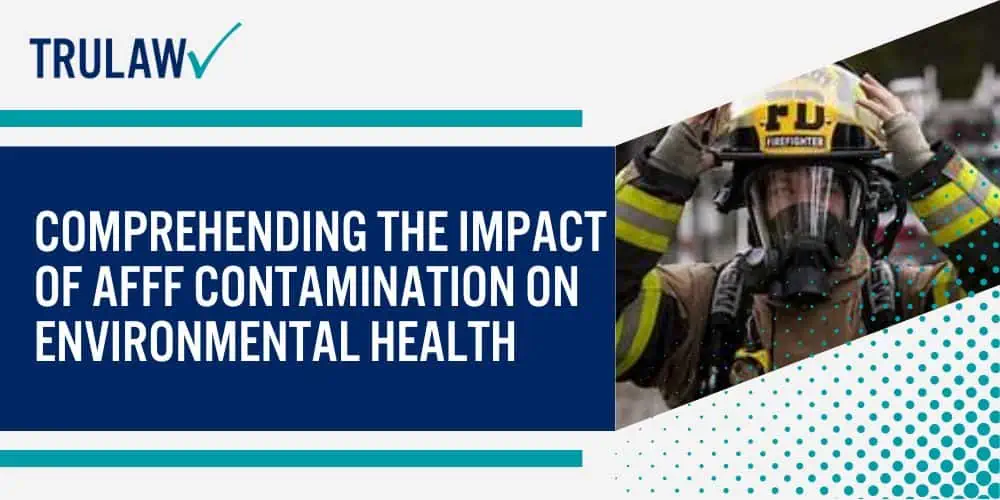
Such changes aim to balance safety requirements with sustainable practices to mitigate environmental risks while ensuring effective firefighting capabilities.
As we progress, we must continue enhancing safety measures without compromising our planet’s health or well-being.
AFFF Contamination: Safeguarding Environmental Health
Aqueous Film Forming Foam (AFFF), primarily used by firefighters, contains harmful PFAS chemicals.
These are often called “forever chemicals” due to their persistence in the environment and our bodies.
Evidence has shown that AFFF contamination can pose serious health risks like kidney, testicular, and prostate cancer.
This alarming discovery has led to several AFFF cancer lawsuits.
Moreover, it’s not just human health at risk; the environment suffers too.
When discharged during firefighting drills or emergencies, toxic components of this foam seep into the ground and contaminate water sources.
They damage aquatic ecosystems over time, disrupting local wildlife populations and impacting biodiversity negatively.
So what steps can be taken?
Banning AFFF MDL does seem like the obvious solution, but transitioning towards safer alternatives is a complex process riddled with challenges.
It involves re-educating fire departments on new protocols while ensuring these options effectively extinguish fires.
This issue also calls for proper disposal mechanisms for existing stocks of AFFF foam remaining across various fire stations globally, a task easier said than done given its hazardous nature!
However difficult it may be, taking action now will ensure a healthier tomorrow for both people and the planet.
Eco-Friendly Alternatives: Balancing Safety and Environmental Impact
Switching to eco-friendly alternatives in the firefighting industry is no longer just a matter of choice but an urgent requirement.
The harmful effects of AFFF Firefighting foam and its constituents are significant enough for us to see a surge in research around safer options.
However, it’s not as simple as swapping one solution for another; these new alternatives must also provide our firefighters with comparable fire-extinguishing power and safety while ensuring minimal environmental harm.
Many firefighting agencies have started transitioning towards fluoro-free foams due to their low environmental footprint.
These foams promise reduced contamination risks without compromising effectiveness, presenting them as viable substitutes for AFFF.
There are challenges though consistent performance across various fire scenarios, cost considerations, compatibility with existing equipment, and stringent regulations can present formidable obstacles during adoption.
New technologies are also emerging; water mist systems and gel-based extinguishers now show potential as green firefighting solutions that meet operational requirements and ecological concerns.
It might demand more time before we can hit an ideal balance between safety and sustainability.
But the progress so far looks promising: a future where effective firefighting doesn’t mean putting health or the environment at risk seems achievable now more than ever.
Regulatory Responses: AFFF Contamination and Safety Measures
In response to AFFF contamination, extensive regulatory measures have taken center stage.
Regulatory bodies worldwide acknowledge the harmful effects of firefighting foam on humans and the environment due to PFAS chemicals.
Approaches are being formulated proactively to ensure safety standards that protect firefighters and communities.
These measures include stringent AFFF Cancer Foam usage restrictions, strict disposal guidelines for existing stocks, and exploring alternatives free from toxic PFAS.
Furthermore, innovation in firefighting equipment is key to these safety measures.
Enhanced gear designed specifically for AFFF-free practices helps reduce exposure risks significantly while meeting legal requirements.
Additionally, enforcing policies about transitioning towards safer firefighting agents remains a top priority for regulatory bodies seeking to mitigate adverse health effects associated with contact with or ingesting substances like AFFF.
AFFF Foam Disposal Practices: Safety and Legal Considerations
The process of AFFF foam disposal requires stringent measures to ensure safety and legal compliance.
This practice is more than simply discarding unused or old foam; it extends to mitigate potential exposure risks associated with harmful chemicals in the foam.
Proper disposal techniques are critical not only for firefighter safety but also for broader environmental health.
Legal considerations play a significant role in shaping these practices.
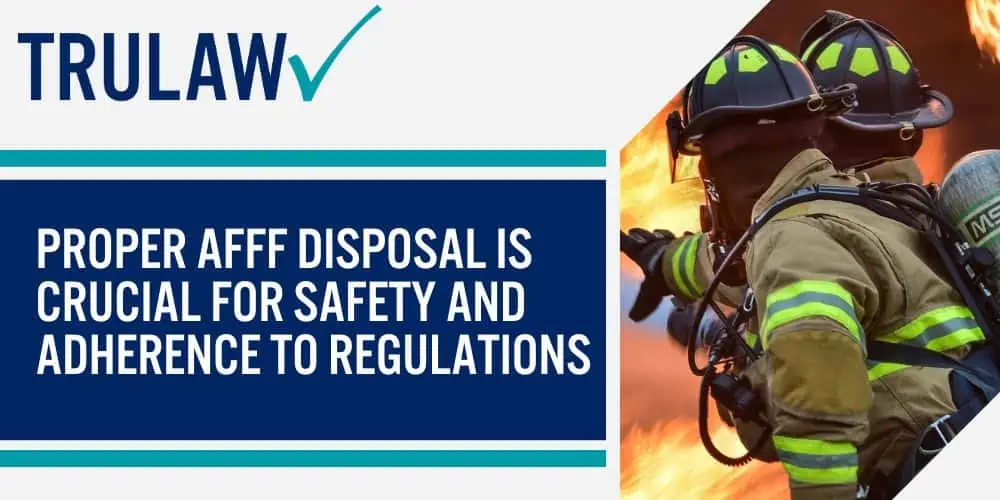
With many lawsuits being filed due to ill effects from AFFF exposure, regulatory bodies enforce strict rules surrounding its use and disposal.
Understanding these regulations helps organizations avoid potential litigation and improve their firefighting procedures.
Firefighting entities must stay up-to-date on evolving laws around AFFF foam lawsuit use, ensuring they remain within guidelines while prioritizing safety at all times.
Proper AFFF Disposal: Ensuring Safety and Compliance
Understanding the importance of adequate AFFF disposal contributes significantly to the safety and regulatory compliance.
In understanding the AFFF disposal, here are some key steps for ensuring the correct handling.
- Identify any existing supplies of AFFF within your organization.
- Check state PFAS laws containing AFFF selection, storage, testing, treatment, and disposal.
- Designate a containment area specifically for AFFF products.
- Employ correct treatment measures to prevent harm to humans and the environment.
- Dispose of used or outdated foam in an environmentally responsible way following state regulations.
- Maintain the record of disposal actions for future reference and compliance audits.
- Stay informed about ongoing AFFF lawsuits and settlement talks for updates on regulatory changes.
- Prioritize transitioning to safer firefighting alternatives as part of your organization’s risk management strategies.
Legal Aspects of AFFF Foam Disposal: Mitigating Liability
Disposing of AFFF foam in a legally compliant manner necessitates understanding and adhering to state and federal guidelines.
The goal is to safeguard the environment from contamination and limit potential liability for improper disposal.
Ignorance or violation of these regulations enhances liability, leading to legal challenges, including hefty fines and penalties.
Manufacturers are confronted with lawsuits alleging conscious disregard of health risks associated with PFAS chemicals in AFFF foam.
These lawsuits highlight the importance of conducting business responsibly while minimizing harm to human health and the environment.
Moreover, they underscore the need for better education concerning proper disposal practices that can help mitigate environmental pollution, enhance safety protocols, protect firefighting personnel, and ultimately reduce legal risks.
Disposal Best Practices: Minimizing Environmental and Health Risks
Proper disposal of aqueous film-forming foam, commonly known as AFFF, is critical to limit its negative environmental and health impacts.
Directly letting out AFFF can cause contamination issues and pose health risks.
- Educate firefighting teams about potential risks: Firefighters need information on how their use and disposal of AFFF can affect environmental and personal safety.
- Implement a containment plan: Create protocols for accidental AFFF releases to prevent harmful exposure and environmental damage.
- Investigate alternative firefighting foams: Consider using less-harmful substitutes to lower the risk of contamination and ensure firefighter safety.
- Contribute towards research: Support studies investigating safe disposal methods or safer firefighting alternatives.
- Be vigilant in waste management: Ensure proper handling, storage, and packaging before dispatching AFFF waste for disposal.
- Communicate with local communities: Keep neighboring areas informed about your practices to mitigate fear, foster trust, and encourage cooperation.
- Regularly review practices: Update disposal guidelines as new research emerges or regulations change to minimize potential risks.
AFFF Lawsuit Relevance and Firefighting Equipment Advancements
The AFFF lawsuit concerning firefighting equipment advancements has triggered a significant safety gear design and application shift.
Manufacturers are now under intense scrutiny to reduce the PFAS chemical content in their products.
This lawsuit has led to an innovative surge in creating safer alternatives, placing firefighter health at the forefront of development strategies.
Firefighters face amplified risks due to prolonged exposure to AFFF during active duty and training sessions.
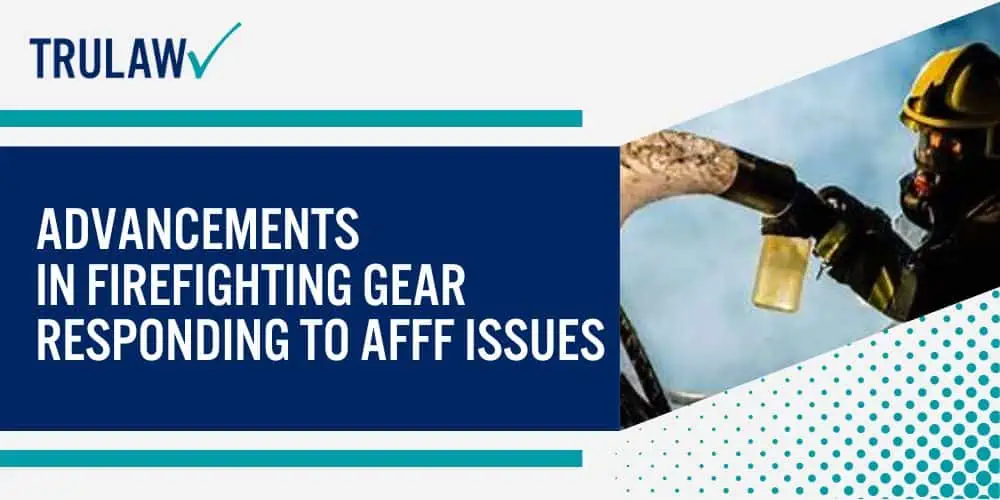
Equipment manufacturers have introduced enhanced gears that limit direct contact with hazardous substances.
AFFF-free firefighting practices are now more widely adopted thanks to increased legal requirements and safety standards sparked by these lawsuits.
Innovations continue within this context while considering both environmental impact and effectiveness in suppressing fires.
These developments aim not only to conform with legal directives but also to ensure that the well-being of firefighters across America is firmly prioritized.
Innovations in Firefighting Equipment: Adapting to AFFF Concerns
The global transition from AFFF firefighting foam has stimulated novel innovations in the fire protection industry.
Businesses are diligently creating safer, more effective solutions to meet the demands of law and health measures.
Firefighting equipment manufacturers have developed new tools to utilize these alternative foams efficiently.
For instance, fire nozzles have seen design refinements for better dispersal alternative foam agents.
In addition to advancements in hardware, technology also plays a significant role in shifting toward an AFFF-free future.
Firefighters currently use software that assists them in making quick decisions during emergencies, taking into account factors like wind direction, substance involved, and nearest water source while calculating the optimal mix ratio of water-based extinguishing agents.
This innovation makes firefighting operations safer and contributes significantly to environmental conservation by optimizing resource usage.
Safety Upgrades: Equipment Enhancements Post-AFFF Lawsuits
Following the AFFF lawsuits, significant safety enhancements have been made to firefighting equipment.
Manufacturers are now pressing towards improved design and production of gear that minimizes exposure risks, focusing on functionality and safety.
Equipment such as fire-resistant suits, helmets, boots, and gloves have been reevaluated to incorporate safer materials.
Engineered solutions like advanced fire-suppressant delivery systems are also gaining attention in the industry.
These upgrades aim to mitigate dangerous contact with carcinogenic substances during firefighting operations.
Innovations extend beyond personal protective gear into broader areas of fire suppression technology.
Tools like foam concentrate proportions and discharge devices are also revolutionizing to ensure efficient AFFF-free operations.
No longer is cost-effectiveness at the forefront – manufacturers have prioritized firefighter health since the AFFF lawsuits surfaced.
From design conception through production phases, they confirm that equipment meets high safety standards while performing its vital task effectively in diverse emergency scenarios.
AFFF-Free Gear: Meeting Legal Requirements and Safety Standards
Firefighters face the dual challenge of protecting lives and property from fires while limiting exposure to potentially harmful substances.
The shift towards AFFF-free firefighting gear is a significant leap forward.
New technologies are being developed to eliminate PFAS chemicals, typically found in AFFF foams, promoting health and longevity among firefighting personnel.
Manufacturers have started producing fire suppression equipment that does not rely on AFFF.
This innovative gear meets legal requirements and safety standards without compromising efficiency or effectiveness.
Fire departments worldwide are beginning to invest in this gear as part of their commitment to fostering safer environments for firefighters.
Enforcing strict compliance with laws governing the production, use, and disposal of AFFF is crucial in managing its impact on human health and the environment.
Legal initiatives such as lawsuits against manufacturers like 3M and DuPont are pivotal in driving these changes by holding them accountable for any harm caused by their products containing PFAS compounds.
AFFF Lawsuit-Free Firefighting Practices and Legal Initiatives
In the wake of AFFF lawsuits, firefighting practices are undergoing significant changes.
The focus is shifting toward adopting alternatives to AFFF – a known carcinogenic agent.
These replacements not only enhance safety for firefighters but also protect communities and the environment at large from contamination.
Legal initiatives stood as key drivers in this transition.
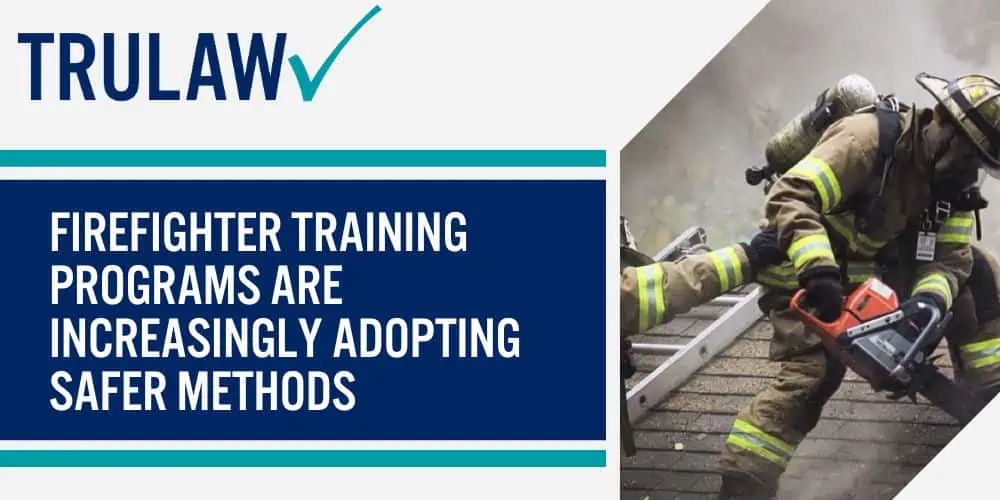
Regulatory bodies have started enforcing stringent rules governing the use of firefighting foams containing PFAS chemicals.
Manufacturers now face accountability for concealing health risks associated with their products, leading to increased transparency in industry operations and product disclosures.
Adopting safer firefighting practices is also making its way into firefighter training programs.
Fire departments nationwide emphasize understanding new equipment, procedures, and foam alternatives during their sessions to ensure a smooth transition from AFFF usage.
Moreover, legal efforts continue to aim to raise public awareness about AFFF hazards.
Lawsuit-driven updates influence local community engagement actions, producing comprehensive education campaigns on risk reduction strategies surrounding potential exposure scenarios to toxic firefighting foams.
On a larger scope, these legal battles are pushing lawmakers into regulatory reforms that respond adequately to concerns regarding occupational safety and environmental conservation related to using toxic fire suppressants such as AFFFs.
Enforcing AFFF-Free Policies: Legal Measures and Enforcement
Lawmakers and regulators are working towards an AFFF-free future, embodying the legal measures to embrace firefighting practices devoid of toxic foam.
Influential agencies such as the Environmental Protection Agency (EPA) spearhead efforts to regulate AFFF usage and mitigate potential health risks.
These bodies play a crucial role in imposing restrictions on foam manufacturing, setting stringent disposal guidelines, and monitoring compliance among stakeholders.
In parallel with regulatory initiatives, lawsuits about AFFF further compel change toward environmentally friendly substitutes.
Specifically, these class action suits underscore environmental concerns while pushing for safer firefighting alternatives.
Notably, personal injury claims featured within multidistrict litigation (MDL) highlight manufacturer liability for adverse health effects linked to longtime exposure – pressuring industry attitudinal shifts towards non-toxic options that satisfy both safety needs and legal requirements.
The transition from traditional chemical-laden AFFF demands a comprehensive understanding of duty-of-care obligations across all levels of business operations.
Fire departments nationwide must prioritize adequate staff training about safe handling procedures under new policies.
The emphasis is not only on the correct use of replacements but also on proper disposal methods for existing AFFF stocks, thereby reducing the risk of contamination.
Moreover, persistent community engagement activities in light of legal developments have started informing public opinion about potential dangers associated with aqueous film-forming foams (AFFF).
This growing consciousness encourages local enforcement routines and provokes debates about state-level law amendments where areas still permit unrestricted use or possession of harmful products.
Advocating for Regulatory Changes: Legal Strategies for AFFF-Free Practices
Legal strategies are crucial in promoting AFFF-free practices within the firefighting industry.
AFFF Lawyers use these tactics to argue for regulatory changes that enhance the safety of firefighters and hold manufacturers responsible for health risks associated with PFAS chemicals in firefighting foam.
Successful lawsuits against manufacturing giants pave the way toward redesigned regulations, thus compelling industries to pursue safer alternatives.
It’s essential to recognize that states gradually prohibit PFAS-based foam, ushering in an era of AFFF-free practices.
These legislative changes manifest through legal initiatives advocating safer firefighting methods and equipment.
Advancements in gear technology also follow such lawsuits; focusing on producing effective but safe-to-use materials indicates a shift toward prioritizing firefighter health over other corporate interests.
AFFF lawsuits have increased over time, emphasizing growing concern among firefighters about their well-being when exposed to harmful substances during duty hours.
Instances of symptoms or side effects should always be discussed with AFFF lawyers who can evaluate potential compensation claims, ensuring those affected can seek the justice they deserve while fostering necessary reforms across boardrooms and legislation.
Lawsuits as Agents of Change: Legal Initiatives for Firefighter Safety
Legal initiatives are transforming firefighting safety, thanks to lawsuits related to AFFF.
These legal actions highlight the critical health risks and environmental hazards of using this most common firefighting foam.
Prominent factors in these cases are allegations of contamination and injury by firefighters, military personnel, and airport workers nationwide.
The slow yet steady progression of the lawsuit points towards a potential reshaping of how we manage fire safety protocols.
The extensive expertise demonstrated by law firms specializing in AFFF lawsuits has played a pivotal role in giving voice to those affected.
Projected settlements hint at concrete changes on the horizon, which could have far-reaching implications for firefighting practices in the future.
In response to these legal endeavors, eco-friendly alternatives are being explored more aggressively.
This fomentation for change pushes manufacturers into reevaluating their products’ safety standards while balancing effectiveness during life-threatening fires.
Furthermore, these unfolding legal debates spur broader awareness about the dangers associated with unsafe AFFF firefighting foams among communities—potentially heralding an era where citizens are better informed about such hazards within their environment.
Lastly, laws governing the use and disposal of hazardous substances like AFFF could undergo considerable changes once mandated through regulatory responses triggered by ongoing lawsuits.
Thus dramatically insisting upon safer fire-fighting practices being enforced across all operating environments.
AFFF Lawsuits in Promoting Safety Community Awareness
AFFF lawsuits play a crucial role in promoting safety and community awareness.
They highlight the dangers associated with Aqueous Film Forming Foam (AFFF), commonly used in firefighting, and drive changes towards safer alternatives.
The initiation of these legal battles against major manufacturers like 3M and DuPont has brought to light health risks related to AFFF exposure.
These lawsuits empower communities by providing them with essential knowledge about potential hazards linked with AFFF usage, such as types of cancers and kidney issues.
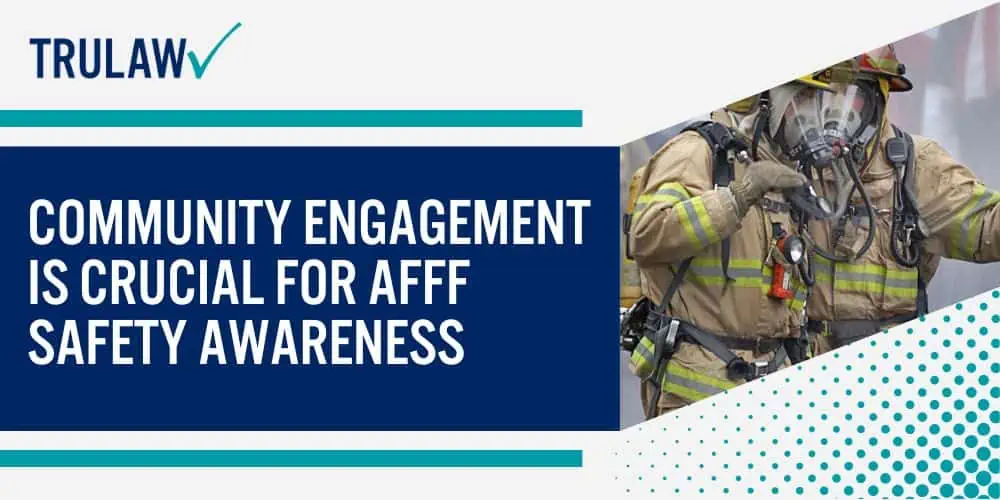
Furthermore, they guide the implementation of public education initiatives that inform citizens on how they can help mitigate further contamination caused by improper disposal of this toxic foam.
These interactions between legal actions, safety practices, and public engagement create a more informed society ready to endorse better firefighting methods for our collective well-being.
Community Engagement: Raising Awareness about AFFF and Safety
Community engagement is pivotal in raising awareness about AFFF and its related safety concerns.
Organizing open forums for community discussions can help share information about AFFF’s potential health risks.
Educational campaigns at local schools and community centers can introduce the dangers of AFFF to a wider audience.
Collaboration with local media outlets can amplify the message, ensuring more people understand the issue.
Public demonstrations of safer firefighting alternatives can familiarize communities with new practices.
Establishing partnerships with firefighter associations to endorse safety campaigns reinforces their importance.
Advocacy groups can use litigation news, such as the ongoing AFFF lawsuits, to highlight issues and lobby for policy changes.
An open dialogue about the health hazards firefighters face due to exposure to toxic chemicals boosts community support for safer practices.
Regular updates on legal measures, such as settlement amounts from completed AFFF-related lawsuits, keep the community informed.
AFFF Lawsuits and Public Education: Empowering Communities
Public education plays a significant role in creating awareness about AFFF lawsuits and fostering safer communities.
Here are some ways communities can be empowered:
Community Safety Partnerships: AFFF Lawsuits and Awareness Campaigns
Community safety partnerships play a crucial role in the aftermath of AFFF lawsuits, particularly through awareness campaigns.
Partnerships with local community organizations have led to widespread educational programs about the implications of AFFF usage.
Fire departments are taking steps to inform communities about the ongoing litigation and potential health risks associated with exposure to toxic firefighting foam.
Local governments are utilizing social media platforms and public health forums for advocacy and raising awareness about the health and environmental issues linked with AFFF foam.
Awareness campaigns aim to educate firefighters about safer alternatives to AFFF and necessary precautions when handling existing AFFF supplies.
Public education efforts target areas near military bases where contamination from firefighting foam is most likely.
Lawsuit updates, shared through these community partnerships, provide transparency on progress toward justice for victims of AFFF contamination.
Grassroots organizations are pushing legislative bodies for stricter regulations on toxic chemicals found in products like AFFF.
Local communities organize fundraising events to support cancer patients who developed their illness due to exposure to toxic firefighting foam.
One-to-one community counseling sessions help those affected understand their legal rights, focusing especially on those who can file an AFFF lawsuit.
Conclusion
Through ongoing AFFF lawsuits, enhancements in safety standards are anticipated across firefighting practices.
This necessary shift demands a balanced blend of legal accountability, environmental sustainability, and community empowerment.
With continual advancements in technology and legislation, we envision safer firefighting techniques ensuring occupational welfare and community well-being.
The transformation to an AFFF-free era will inevitably mark a milestone in the history of modern firefighting practices.
AFFF Lawsuit Frequently Asked Questions
-
The AFFF lawsuit consists of legal actions against various manufacturers of Aqueous Film Forming Foam, alleging they concealed the dangers of toxic PFAS chemicals that caused cancer and environmental contamination.
As of November 2023, these lawsuits have resulted in many pending cases and a major settlement.
TruLaw offers legal assistance to individuals affected by AFFF exposure.
Contact us for a free consultation today.
-
Yes, numerous current and pending AFFF litigation cases have been filed nationwide, addressing issues like firefighter foam lawsuit settlement amounts and wrongful death allegations.
-
The parties in these lawsuits often involve the city, like the City of Stuart V., Tyco Fire Products, 3M Co et al., who are associated with manufacturing or using firefighting foam products that allegedly caused harm.
-
In some instances, multiple plaintiffs join together, forming an ‘AFFF Class Action Lawsuit,’ which operates under the guidance of AFFF Firefighting Foam lawsuit Lawyers specializing in prior mass tort cases, aiming for shared resolution.
-
Yes, Individual firefighters can initiate their specific case as part of an overarching AFFF Firefighting Foam Lawsuits Multidistrict Litigation, sometimes following severe health impacts such as kidney and testicular cancer diagnosis linked to exposure.

Managing Attorney & Owner
With over 25 years of legal experience, Jessica Paluch-Hoerman is an Illinois lawyer, a CPA, and a mother of three. She spent the first decade of her career working as an international tax attorney at Deloitte.
In 2009, Jessie co-founded her own law firm with her husband – which has scaled to over 30 employees since its conception.
In 2016, Jessie founded TruLaw, which allows her to collaborate with attorneys and legal experts across the United States on a daily basis. This hypervaluable network of experts is what enables her to share the most reliable, accurate, and up-to-date legal information with our readers!
Additional AFFF Lawsuit resources on our website:
Here, at TruLaw, we’re committed to helping victims get the justice they deserve.
Alongside our partner law firms, we have successfully collected over $3 Billion in verdicts and settlements on behalf of injured individuals.
Would you like our help?
At TruLaw, we fiercely combat corporations that endanger individuals’ well-being. If you’ve suffered injuries and believe these well-funded entities should be held accountable, we’re here for you.
With TruLaw, you gain access to successful and seasoned lawyers who maximize your chances of success. Our lawyers invest in you—they do not receive a dime until your lawsuit reaches a successful resolution!
AFFF Lawsuit claims are being filed against manufacturers of aqueous film-forming foam (AFFF), commonly used in firefighting.
Claims allege that companies such as 3M, DuPont, and Tyco Fire Products failed to adequately warn users about the potential dangers of AFFF exposure — including increased risks of various cancers and diseases.
Depo Provera Lawsuit claims are being filed by individuals who allege they developed meningioma (a type of brain tumor) after receiving Depo-Provera birth control injections.
A 2024 study found that women using Depo-Provera for at least 1 year are five times more likely to develop meningioma brain tumors compared to those not using the drug.
Suboxone Tooth Decay Lawsuit claims are being filed against Indivior, the manufacturer of Suboxone, a medication used to treat opioid addiction.
Claims allege that Indivior failed to adequately warn users about the potential dangers of severe tooth decay and dental injuries associated with Suboxone’s sublingual film version.
Social Media Harm Lawsuits are being filed against social media companies for allegedly causing mental health issues in children and teens.
Claims allege that companies like Meta, Google, ByteDance, and Snap designed addictive platforms that led to anxiety, depression, and other mental health issues without adequately warning users or parents.
Transvaginal Mesh Lawsuits are being filed against manufacturers of transvaginal mesh products used to treat pelvic organ prolapse (POP) and stress urinary incontinence (SUI).
Claims allege that companies like Ethicon, C.R. Bard, and Boston Scientific failed to adequately warn about potential dangers — including erosion, pain, and infection.
Bair Hugger Warming Blanket Lawsuits involve claims against 3M — alleging their surgical warming blankets caused severe infections and complications (particularly in hip and knee replacement surgeries).
Plaintiffs claim 3M failed to warn about potential risks — despite knowing about increased risk of deep joint infections since 2011.
Baby Formula NEC Lawsuit claims are being filed against manufacturers of cow’s milk-based baby formula products.
Claims allege that companies like Abbott Laboratories (Similac) and Mead Johnson & Company (Enfamil) failed to warn about the increased risk of necrotizing enterocolitis (NEC) in premature infants.
Here, at TruLaw, we’re committed to helping victims get the justice they deserve.
Alongside our partner law firms, we have successfully collected over $3 Billion in verdicts and settlements on behalf of injured individuals.
Would you like our help?
